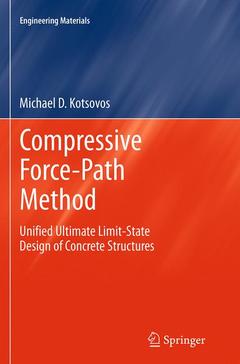Description
Compressive Force-Path Method, 2014
Unified Ultimate Limit-State Design of Concrete Structures
Engineering Materials Series
Language: English
Subject for Compressive Force-Path Method:
Compressive Force-Path Method
Publication date: 08-2016
Support: Print on demand
Publication date: 08-2016
Support: Print on demand
Compressive Force-Path Method
Publication date: 10-2013
221 p. · 15.5x23.5 cm · Hardback
Publication date: 10-2013
221 p. · 15.5x23.5 cm · Hardback
Description
/li>Contents
/li>Biography
/li>Comment
/li>
This book presents a method which simplifies and unifies the design of reinforced concrete (RC) structures and is applicable to any structural element under both normal and seismic loading conditions. The proposed method has a sound theoretical basis and is expressed in a unified form applicable to all structural members, as well as their connections. It is applied in practice through the use of simple failure criteria derived from first principles without the need for calibration through the use of experimental data. The method is capable of predicting not only load-carrying capacity but also the locations and modes of failure, as well as safeguarding the structural performance code requirements.
In this book, the concepts underlying the method are first presented for the case of simply supported RC beams. The application of the method is progressively extended so as to cover all common structural elements. For each structural element considered, evidence of the validity of the proposed method is presented together with design examples and comparisons with current code specifications. The method has been found to produce design solutions which satisfy the seismic performance requirements of current codes in all cases investigated to date, including structural members such as beams, columns, and walls, beam-to-beam or column-to-column connections, and beam-to-column joints.
In this book, the concepts underlying the method are first presented for the case of simply supported RC beams. The application of the method is progressively extended so as to cover all common structural elements. For each structural element considered, evidence of the validity of the proposed method is presented together with design examples and comparisons with current code specifications. The method has been found to produce design solutions which satisfy the seismic performance requirements of current codes in all cases investigated to date, including structural members such as beams, columns, and walls, beam-to-beam or column-to-column connections, and beam-to-column joints.
Reappraisal of concepts underlying reinforced concrete design.- The concept of the compressive-force path.- Modelling of simply-supported beams.- Design of simply supported beams.- Design for punching of flat slabs.- Design of skeletal structures with beam-like elements.- Earthquake-resistant design.- Design examples.
Michael D. Kotsovos is full professor of Civil and Building Engineering, and Director of the Laboratory of Reinforced Concrete Structures at the National Technical University of Athens, Greece.
Describes a method suitable not only for designing new earthquake-resistant RC structures but also for the structural assessment and redesign/upgrading of existing RC structures Clearly explains the concepts underlying the method and its application to all common structural elements Presents evidence of the validity of the method plus design examples and comparisons with current code specifications Includes supplementary material: sn.pub/extras
© 2024 LAVOISIER S.A.S.




